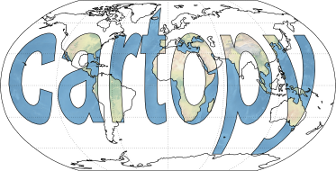# Copyright Crown and Cartopy Contributors
#
# This file is part of Cartopy and is released under the BSD 3-clause license.
# See LICENSE in the root of the repository for full licensing details.
"""
Extra functionality that is primarily intended for developers, providing support for
transforming between Shapely geometries and Matplotlib paths.
See also `Shapely Geometric Objects
<https://shapely.readthedocs.io/en/latest/manual.html#geometric-objects>`_
and `Matplotlib Path API <https://matplotlib.org/stable/api/path_api.html>`_.
"""
import warnings
from matplotlib.path import Path
import numpy as np
import shapely.geometry as sgeom
import cartopy.mpl.path as cpath
[docs]
def geos_to_path(shape):
"""
Create a list of :class:`matplotlib.path.Path` objects that describe
a shape.
.. deprecated:: 0.25
Use `cartopy.mpl.path.shapely_to_path` instead.
Parameters
----------
shape
A list, tuple or single instance of any of the following
types: :class:`shapely.geometry.point.Point`,
:class:`shapely.geometry.linestring.LineString`,
:class:`shapely.geometry.polygon.LinearRing`,
:class:`shapely.geometry.polygon.Polygon`,
:class:`shapely.geometry.multipoint.MultiPoint`,
:class:`shapely.geometry.multipolygon.MultiPolygon`,
:class:`shapely.geometry.multilinestring.MultiLineString`,
:class:`shapely.geometry.collection.GeometryCollection`,
or any type with a _as_mpl_path() method.
Returns
-------
paths
A list of :class:`matplotlib.path.Path` objects.
"""
warnings.warn("geos_to_path is deprecated and will be removed in a future release."
" Use cartopy.mpl.path.shapely_to_path instead.",
DeprecationWarning, stacklevel=2)
if isinstance(shape, (list, tuple)):
paths = []
for shp in shape:
paths.extend(geos_to_path(shp))
return paths
if isinstance(shape, sgeom.LinearRing):
return [Path(np.column_stack(shape.xy), closed=True)]
elif isinstance(shape, (sgeom.LineString, sgeom.Point)):
return [Path(np.column_stack(shape.xy))]
elif isinstance(shape, sgeom.Polygon):
def poly_codes(poly):
codes = np.ones(len(poly.xy[0])) * Path.LINETO
codes[0] = Path.MOVETO
codes[-1] = Path.CLOSEPOLY
return codes
if shape.is_empty:
return []
vertices = np.concatenate([np.array(shape.exterior.xy)] +
[np.array(ring.xy) for ring in
shape.interiors], 1).T
codes = np.concatenate([poly_codes(shape.exterior)] +
[poly_codes(ring) for ring in shape.interiors])
return [Path(vertices, codes)]
elif isinstance(shape, (sgeom.MultiPolygon, sgeom.GeometryCollection,
sgeom.MultiLineString, sgeom.MultiPoint)):
paths = []
for geom in shape.geoms:
paths.extend(geos_to_path(geom))
return paths
elif hasattr(shape, '_as_mpl_path'):
vertices, codes = shape._as_mpl_path()
return [Path(vertices, codes)]
else:
raise ValueError(f'Unsupported shape type {type(shape)}.')
[docs]
def path_segments(path, **kwargs):
"""
Create an array of vertices and a corresponding array of codes from a
:class:`matplotlib.path.Path`.
.. deprecated:: 0.25
Parameters
----------
path
A :class:`matplotlib.path.Path` instance.
Other Parameters
----------------
kwargs
See `matplotlib.path.Path.iter_segments` for details of the keyword
arguments.
Returns
-------
vertices, codes
A (vertices, codes) tuple, where vertices is a numpy array of
coordinates, and codes is a numpy array of matplotlib path codes.
See :class:`matplotlib.path.Path` for information on the types of
codes and their meanings.
"""
warnings.warn(
"path_segments is deprecated and will be removed in a future release.",
DeprecationWarning, stacklevel=2)
return cpath._path_segments(path, **kwargs)
[docs]
def path_to_geos(path, force_ccw=False):
"""
Create a list of Shapely geometric objects from a
:class:`matplotlib.path.Path`.
.. deprecated:: 0.25
Use `cartopy.mpl.path.path_to_shapely` instead.
Parameters
----------
path
A :class:`matplotlib.path.Path` instance.
Other Parameters
----------------
force_ccw
Boolean flag determining whether the path can be inverted to enforce
ccw. Defaults to False.
Returns
-------
A list of instances of the following type(s):
:class:`shapely.geometry.polygon.Polygon`,
:class:`shapely.geometry.linestring.LineString` and/or
:class:`shapely.geometry.multilinestring.MultiLineString`.
"""
warnings.warn("path_to_geos is deprecated and will be removed in a future release."
" Use cartopy.mpl.path.path_to_shapely instead.",
DeprecationWarning, stacklevel=2)
# Convert path into numpy array of vertices (and associated codes)
path_verts, path_codes = cpath._path_segments(path, curves=False)
# Split into subarrays such that each subarray consists of connected
# line segments based on the start of each one being marked by a
# matplotlib MOVETO code.
verts_split_inds = np.where(path_codes == Path.MOVETO)[0]
verts_split = np.split(path_verts, verts_split_inds)
codes_split = np.split(path_codes, verts_split_inds)
# Iterate through the vertices generating a list of
# (external_geom, [internal_polygons]) tuples.
other_result_geoms = []
collection = []
for path_verts, path_codes in zip(verts_split, codes_split):
if len(path_verts) == 0:
continue
if path_codes[-1] == Path.CLOSEPOLY:
path_verts[-1, :] = path_verts[0, :]
verts_same_as_first = np.isclose(path_verts[0, :], path_verts[1:, :],
rtol=1e-10, atol=1e-13)
verts_same_as_first = np.logical_and.reduce(verts_same_as_first,
axis=1)
if all(verts_same_as_first):
geom = sgeom.Point(path_verts[0, :])
elif path_verts.shape[0] > 4 and path_codes[-1] == Path.CLOSEPOLY:
geom = sgeom.Polygon(path_verts[:-1, :])
else:
geom = sgeom.LineString(path_verts)
# If geom is a Polygon and is contained within the last geom in
# collection, it usually needs to be an interior to that geom (e.g. a
# lake within a land mass). Sometimes there is a further geom within
# this interior (e.g. an island in a lake, or some instances of
# contours). This needs to be a new external geom in the collection.
if geom.is_empty:
pass
elif (len(collection) > 0 and
isinstance(collection[-1][0], sgeom.Polygon) and
isinstance(geom, sgeom.Polygon) and
collection[-1][0].contains(geom.exterior)):
if any(internal.contains(geom) for internal in collection[-1][1]):
collection.append((geom, []))
else:
collection[-1][1].append(geom)
elif isinstance(geom, sgeom.Point):
other_result_geoms.append(geom)
else:
collection.append((geom, []))
# Convert each (external_geom, [internal_polygons]) pair into a
# a shapely Polygon that encapsulates the internal polygons, if the
# external geom is a LineString leave it alone.
geom_collection = []
for external_geom, internal_polys in collection:
if internal_polys:
exteriors = [geom.exterior for geom in internal_polys]
geom = sgeom.Polygon(external_geom.exterior, exteriors)
else:
geom = external_geom
# Correctly orientate the polygon (ccw)
if isinstance(geom, sgeom.Polygon):
if force_ccw and not geom.exterior.is_ccw:
geom = sgeom.polygon.orient(geom)
geom_collection.append(geom)
# If the geom_collection only contains LineStrings combine them
# into a single MultiLinestring.
if geom_collection and all(isinstance(geom, sgeom.LineString) for
geom in geom_collection):
geom_collection = [sgeom.MultiLineString(geom_collection)]
# Remove any zero area Polygons
def not_zero_poly(geom):
return ((isinstance(geom, sgeom.Polygon) and not geom.is_empty and
geom.area != 0) or
not isinstance(geom, sgeom.Polygon))
result = list(filter(not_zero_poly, geom_collection))
return result + other_result_geoms
